The Lawrence Welk of Cartoonists
Ernie, Nancy, and the Bushmiller Society
Various among us have long been baffled and sometimes afflicted by the persistent presence, lurking at the fringes of cartoon afficionadom—or, sometimes, burrowed deep, prairie-dog-like, into its heart—of a sect or cultish non-organization of penumbra dimension, cult-ivated (so to speak) by a person or persons unknown. Cartoonist Shannon Wheeler, editor and purveyor of Too Much Coffee Man magazine, professes as much exasperation at the phenomenon as anyone:
“For years,” Shannon admitted many moons ago, “I have been increasingly mystified and fascinated by the shadowy cult of personality that has grown around a highly unlikely figure: the late cartoonist Ernie Bushmiller of Nancy fame.” Wheeler said he has the highest regard for “seminal figures like Carl Barks, Harvey Kurtzman, Will Eisner and Jack Kirby,” but he can’t imagine how Bushmiller has earned a place, admittedly a cloudy one, in the firmament of cartooning. “He was no innovator,” Wheeler snivels. “He inspired no school or technique. His ‘storytelling’ consisted of rudimentary gags and the worst kind of puns. He wasn't even a charismatic figure in life: he was a self-described ‘square’ who referred to himself as ‘the Lawrence Welk of cartoonists.’ His work, to me, seems aimed at simpletons. Nonetheless his enduring appeal is tough to deny, and his hardcore fans reflect a zealotry rare for any artist in modern culture.” In an effort to explain this mysterious and irrational dedication, we now paw through the alleged facts of Bushmiller’s life and work.
Ernest Paul Bushmiller was born August 23, 1905 in the South Bronx, New York, the son of Ernest George Bushmiller, artist, vaudevillian, and bartender, and Elizabeth Hall. Young Ernie quit school after completing the eighth grade and went to work as a copy boy at Joseph Pulitzer’s legendary New York World; evenings, he attended classes at the National Academy of Design. Running errands for the staff cartoonists, he inveigled occasional drawing assignments, one of which was illustrating a Sunday feature about magic written by Harry Houdini.
Early in 1925, Bushmiller was asked to ghost a flapper comic strip called Fritzi Ritz when its originator, Larry Whittington, left to work for William R. Hearst's rival paper, the New York Journal American, where Whittington would concoct another strip about a flapper, Mazie the Model. Cast in the mold of Cliff Sterrett's Polly and Her Pals and launched October 9, 1922, Fritzi Ritz was a "pretty girl strip" the comedy of which is generated by a delectable flapper who wins a beauty contest and becomes a movie actress in the New York film colony.
Bushmiller
was undoubtedly picked to continue Fritzi Ritz because he could limn the
fascinating forms of the opposing gender with panache and verve and a certain
obvious affection. In consequence, Fritzi Ritz gained in popularity,
adding a Sunday page on October 6, 1919, “a sure sign that the strip had become
a solid success,” notes Brian Walker in his seminal tome, The Best of
Ernie Bushmiller’s Nancy (Comicana,1988). Encouraged by his continuing
paycheck, Bushmiller got married, on July 9, 1930, to Abby Bohnet, the daughter
of a train conductor, and the next year, they went to Hollywood where
Bushmiller wrote gags for Harold Lloyd in “Movie Crazy,” continuing Fritzi
Ritz at the same time, increasingly modeling Fritzi’s appearance on that of
his beautiful bride.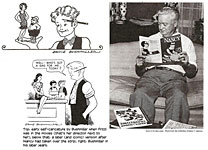
The Bushmillers returned to the Bronx after about a year, but the cartoonist, recognizing that Hollywood not New York was the film capitol, shifted the venue of his strip to the West Coast. This change, however, did not produce as profound an effect on the feature as the introduction on January 2, 1933 of Fritzi's niece, a Brillo-haired slot-nosed seven-year-old named Nancy.
Fritzi in the 1930s was a shapely, sexy glamour girl, and Bushmiller exploited his ability to draw a pretty girl: virtually every time Fritzi strolled into the strip, and every time she sat down—which was often—she assumed a pin-up pose, and she was frequently seen at her dressing table in her underwear or a negligee. Despite this high-voltage sex appeal, Fritzi's fireplug-shaped niece stole the show. The strip told continuing stories in those years, and in 1935, Bushmiller did a continuity about Nancy running away. Although scarcely a tear-jerking sequence, it apparently tugged enough at readers' heartstrings to yank Nancy to their bosoms. Bushmiller had unwittingly permitted his title character to be upstaged. Then on January 24, 1938, Bushmiller introduced Sluggo, the stubbly-headed tough kid who becomes Nancy's constant companion, and before too many more months, the cartoonist capitulated to what was now obvious: Nancy was clearly his star. By the end of 1938, Bushmiller had struck Fritzi's name from the strip's marquee and put Nancy's in its stead. From that point on, the strip ran few continuities. It became a gag-a-day strip.
About his pair of protagonists, Bushmiller said: “They may be brats, but they don’t play with meat choppers or dangerous weapons. I don’t let them get that vicious. I don’t like cruel humor,” he continued. “And I don’t like night club humor, insult humor, where you make fun of somebody. I like the gentle type of humor, a Bob Benchley type.”
Bushmiller refined his art, honed it to its barest essentials, and thereby produced a comic strip that in many respects was the very apotheosis of a comic strip. In simplifying his style, reducing it to the absolute minimum graphic representation necessary for its narrative purpose, Bushmiller transformed his visuals into virtual pictographs, and his strip became a kind of hieroglyphic.
As comics critic Dwight Decker said in Amazing Heroes: "A Bushmiller house is not a drawing of an individual house that could or does exist in reality but a symbol of all houses, of Houseness itself.” Comics theorist Scott McCloud added: “Much has been made of the ‘three rocks.’ Art Spiegelman explains how a drawing of three rocks in a background scene was Ernie’s way of showing us there were some rocks in the background. It was always three. Why? Because two rocks wouldn’t be ‘some rocks.’ Two rocks would be a pair of rocks. And four rocks was unacceptable because four rocks would indicate ‘some rocks’ but it would be one rock more than was necessary to convey the idea of ‘some rocks.’ A Nancy panel is an irreduceable concept, an atom, and the comic strip is a molecule.”
Bushmiller’s distillation of his style to iconography aimed at a single purpose—to deliver the day's joke in as economical a manner as possible. Bushmiller’s approach was “so formulaic as to become the very definition of the ‘gag strip,’” said McCloud.
Bushmiller worked nights mostly. He began about two o’clock in the afternoon and sat at his drawing board into the wee hours and often into the morning of the next day. “I work on a schedule that produces six daily Nancy and Sluggo strips between Sunday and Tuesday evenings,” he wrote in a autobiographical article in Colllier’s (September 18, 1948). “The Sunday page evolves after I’ve taken Wednesday and Thursday off. If this sounds confusing, then you have a fairly accurate picture of a newspaper cartoonist’s life. Unlike other strip cartoonists, I draw the last picture first and work back to toward the beginning, which is exactly the opposite of the way you read it (I hope). I know I guy who draws his cartoons upside down, so I don’t worry much about drawing backwards.”
In conjuring up jokes, Bushmiller came to rely to a great extent upon props, and in so doing, he gave the strip its unique flavor. Describing his method, Bushmiller said: "I jot down items such as toaster, leaky roof, folding chair, mail box, windy day—anything that comes to mind. Looking at the advertising in a magazine also helps, or a Sears Roebuck catalog. When I find an item that seems likely, I start to kick it around in my mind to see if I can work out a funny situation. Let’s say I see an ironing board. I start to think about what can be done with an ironing board, and I pretty soon get an idea."
As a result of this way of working perhaps, Nancy's humor is more consistently visual than many gag strips: an understanding of the gag depends upon comprehending the picture in the last panel, a picture in which the prop plays a vital part. In nearly every installment of the strip during its vintage years (1944-1959), the preceding panels are a verbal build-up to a visual punchline. In this, Bushmiller blended word and picture in such a way that each contributes meaning to the other, both together creating a meaning that neither has by itself—the very definition of the medium.
But Bushmiller's strip was resolutely one-dimensional. Our interest in it as well as our appreciation of its humor stems almost entirely from a kind of grudging admiration for Bushmiller's ingenuity in using physical objects as the bases for his jokes. Virtually every strip is an exercise in problem-solving. Nancy is Bushmiller's alter ego. Her everlasting role is the same as the cartoonist's—to figure out how to use some prop to get a laugh. She reads about a man who believes Martians are living on Earth and two panels later finds spectacles with three lenses. She feeds plant food to her plant, wonders if she’s given it too much, and then it burps at her. She wanders through a funhouse of trick mirrors, and after seeing herself distorted in a dozen ways, she leaves and stops to look at herself in a regular mirror so she can rejoice in how gorgeous she feels. Every day, her raison d'etre is to set up a situation that will lead to the visual punchline of the last panel in which the prop gets the laugh. She has no personality; she is a simple plot device.
Writing in Walker’s Best of Bushmiller, Mark Newgarden and Paul Karasik observe that Bushmiller sacrificed everything to his punchline: "Characterization, atmosphere, emotional depth, social comment, plot, internal consistency, and common sense are all merrily surrendered in Bushmiller's universe to the true function of a comic strip—to provoke the ‘gag reflex' of his readership on a daily basis.”
In one daily installment that might well be the touchstone for the strip, we see Nancy in a rowboat in the first panel, muttering that she’ll “show” Sluggo and Trixie (Sluggo’s current heartthrob, Nancy’s perennial rival) that she doesn’t care about their romance. In the next panel she disembarks the rowboat onto land, saying, “I’ll just ignore them like they don’t exist.”
The camera pulls back for the last panel—the visual punchline. There we see Nancy ignoring Sluggo and Trixie. All three of them are on a tiny island by themselves, entirely isolated. Nancy walks around and around the couple, pointedly looking away from them. The joke is that Nancy, in order to demonstrate that she is oblivious of them, has purposefully sought them out, thereby proving quite the contrary.
The joke works. But it has no context. It comes out of nowhere. Where is this island? Is it a feature of Nancy’s neighborhood? Why are Sluggo and Trixie on it all by themselves? The answer to all such questions is the same: the island is there for the sake of the gag, just as Sluggo and Trixie are. The same statement explains everything in Nancy.
Bushmiller created an autobiographical character who looks like his creator. Named Phil Fumble, he is the title character in the "topper" strip that appeared at the top of the Fritzi Ritz Sunday page. Moving slowly down the page, Phil eventually became Fritzi's permanent beau, creating perhaps the only poetry in Bushmiller's oeuvre: in delineating Fritzi, the cartoonist had been inspired by his wife, so it was appropriate that his look-alike should be a devotee at the same shrine.
One of the founders of the National Cartoonists Society, Bushmiller received its Reuben trophy as Cartoonist of the Year in 1976. He continued drawing Nancy until the late 1970s when Parkinson's Disease rendered him incapable of drawing any longer. With assistants Will Johnson and Al Plastino to do the drawing, Bushmiller supervised the strip's production until his death at Stamford, Connecticut, August 15, 1982. In an act of the profoundly deviant admiration, the New York Times, which normally goes to press without a shred of cartooning in it, published a Nancy strip next to Bushmiller’s obit. The strip continues in circulation to this day: Al Plastino and Mark Lasky did it for a year after the creator’s death, then Jerry Scott carried on for the next ten years (giving Nancy a hideous make-over) through 1994, when Guy and Brad Gilchrist took over; they’re still doing it.
In its simplicity of graphic design, in its single-minded purpose, in its steady reliance upon verbal-visual blending, Nancy is in some respects the quintessential comic strip even though its title character has almost no individual personality. And that, perhaps—the strip’s quintessentiality—is the reason for its secret legions of devotees.
“One clandestine organization in particular has, for three decades, been associated with this cult,” Shannon Wheeler claims, “—the Bushmiller Society. It has no known headquarters. It sets up no tables at comics conventions. It has no web site. Yet Too Much Coffee Man (and other publications I know) finds itself relentlessly bombarded by the cult's aggressive guerrilla tactics. Surreal panels from old Nancy strips and rambling tracts extolling the brilliance of their creator arrive with regularity at this office. But they always arrive anonymously and bear different originating postmarks. I cannot attend a convention without seeing the ubiquitous face of Nancy stuck on the inside door of a public toilet or smiling enigmatically at eye level above a urinal. Stickers, buttons and wooden nickels bearing generic messages—such as ‘The Bushmiller Society Was Here’ or ‘Bushmiller Lives!’ and (my favorite) ‘Dare to be Dumb!’—show up on snack tables or similar locations at comics industry parties. Some professionals seem to take glee in pocketing the free souvenirs, but the host never seem to notice who placed the items there.
“Why Bushmiller?” Wheeler asks, his voice cracking plaintively. “What kind of people are attracted to a Nancy cult? And who is behind the organized weirdness?”
Most industry observers, Wheeler discovered, believe the power behind this cabal of cultists to be one-time underground cartooner and lately publisher Denis Kitchen. Wheeler tracked him down and confronted the illusive sink magnet as recently as 2002.
Accused point-blank of being the mind behind the madness, Kitchen laughed it off, saying that he is to the Bushmiller Society as Jimmy Olson is to Superman: “No one knows how to contact Superman,” Kitchen grinned, “but everyone knows that you can reach Superman through his best friend Jimmy Olson.”
But Kitchen denied even being a member of the Bushmiller Society—although he admitted some early contact with the “group.” He remembered being contacted by “an outfit calling itself the Society of Bushmillerites. I remember it because I sent a note back pointing out that ‘S.O.B.’ was an unfortunate acronym. The next thing I knew, they had changed their name to Bushmiller Society.”
Kitchen also admitted that, as a businessman, he was the first to recognize and exploit the “ancillary market” of Bushmiller fanaddicts, producing numerous Nancy reprint books and ancillary products. Otherwise, throughout Wheeler’s probing interview, Kitchen manages to evade or ignore every accusation that he is actively involved in the nefarious Nancy schemes and machinations. Until, that is, the very end of the interview. For what happens there—and for the entire revealing interview—you should Google “Bushmiller Society” and then go to the one the description of which begins by citing Denis Kitchen’s name.
For information about other frauds and hoaxes associated with the iconic Bushmiller, consult Opus 226 and 227 in the Rancid Raves archives; and read them in order for the full shameful effect.
And now, a gallery of Nancys for your edification and amusement. Among them is a full-page autobiographical comic strip Bushmiller did for a series that Collier’s magazine published in 1948; in it, the cartoonist plays somewhat fast-and-loose with the facts, claiming, among other things, to have invented the Fritzi Ritz strip.
 |
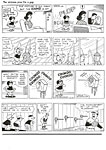 |
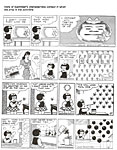 |
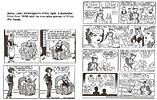 |
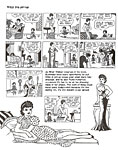 |
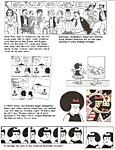 |
Bibliography. Although Nancy was one of the most popular comic strips of the 1940s and 1950s, almost nothing has been written about its creator. Most of the biographical information contained herein can be found as chapter introductions in The Best of Ernie Bushmiller's Nancy, written and edited by Brian Walker, a 1988 volume that reprints a thoughtful sampling of the strip from throughout its run. Most of the illustrations I’ve used here were plucked from this book. Since Walker’s book, Nancy strips have been reprinted in various thematic collections; and lately, a “complete Nancy” series has been announced, beginning in 2011 with Nancy Is Happy: The Complete Dailies 1942-45.
